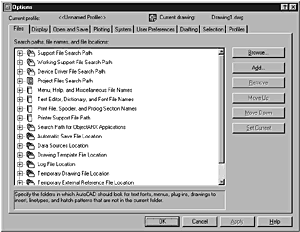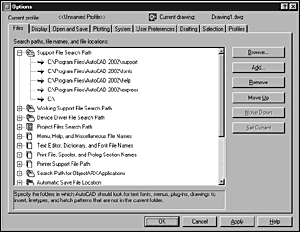Specifying Search Paths and Filenames
When you start AutoCAD, it determines where certain files are that may be used during the drawing session. These items include support files and device drivers, which are located in various folders on your computer system. AutoCAD also determines where to store certain file information, like temporary and backup files. In the Files tab, you specify where to find all the files needed, and where to save temporary and backup files.
The Files tab is located in the Options dialog box, which is accessed from the Tools menu by choosing Options (see Figure 3.1). The Files tab identifies all necessary files and their locations in several folders. The folders are used to organize and display the information into a list of logical groups. As you select each folder in the list, a description is displayed in the description field under the list. The yellow folder icons in the list specify where AutoCAD searches for support, driver, menu, and other files. The white papers icons specify optional, user-defined settings such as which dictionary to use for checking spelling.
Figure 3.1. The Options dialog box controls many of AutoCAD’s features.

By modifying the paths and files in the folders, and adding new information, you can control the files AutoCAD uses during its drawing session. In the following exercise, you add a new path to the Support File Search Path folder, which provides AutoCAD with another folder to look in for files it needs to use during a drawing session.
Exercise 3.1 Adding a New Search Path
1. |
With AutoCAD running, from the Tools menu, choose Options. |
2. |
Choose the Files tab if it is not already displayed. |
3. |
Double-click on the Support File Search Path folder to display its contents. You can also expand a folder by selecting the plus (+) sign. If the sign is minus (-) then the folder is already expanded. |
4. |
Click the Add button to add a new search path. |
5. |
Click the Browse button to display the Browse for Folder dialog box. |
6. |
In the Browse for Folder dialog box, scroll through the list, and choose Local Disk (C:), and then click OK. AutoCAD adds the new path to the Support File Search Path folder, as shown in Figure 3.2. With this new path added, AutoCAD will now search the root of drive C: for any files it needs. However, because you probably don’t keep AutoCAD files at the root, let’s remove the path from the folder. Figure 3.2. A new path is added to the Support File Search Path folder.
|
7. |
Choose the path you just created to highlight it. |
8. |
Click the Remove button to remove the highlighted path from the folder. Warning AutoCAD has default locations for all search paths. Although you can change these locations, caution should be used. If you modify a location, AutoCAD probably will not be able to find the files it needs to run properly. |
Note
Third-party products will frequently place their own menus and LISP routines in separate directories created during installation. If you find that your third-party software is not performing properly, make sure the Support File Search Path and Device Driver File Search Path in the Files tab contain the proper path references.
As you just learned, adding and removing paths is very simple. It’s also very simple to redefine the files AutoCAD uses during the editing session. To demonstrate this, in the following exercise, you replace the current alternate font file setting, Simplex, with Arial.
Exercise 3.2 Replacing the Default Alternate Font File
1. |
Continuing from the previous exercise, click the plus sign (+) in front of the Text Editor, Dictionary, and Font File Names item to expand its list. |
2. |
Click the plus sign (+) in front of the Alternate Font File item to display the current setting of simplex.shx, and then select the Simplex.shx listed. |
3. |
Click the Browse button to display the Alternate Font dialog box. |
4. |
In the Alternate Font dialog box, scroll to the top of the Font Name list, choose the Arial font, then click OK. |
AutoCAD replaces the Simplex Alternate Font File with Arial, as shown in Figure 3.3. If you are satisfied with the changes to the paths and files, you can click the Apply button. However, if you do not want to apply the modified settings, click Cancel.
Figure 3.3. The Alternate Font File is changed to Arial.

As you just learned, modifying the default paths and files AutoCAD uses is easy. Next, you learn about customizing AutoCAD’s display.

